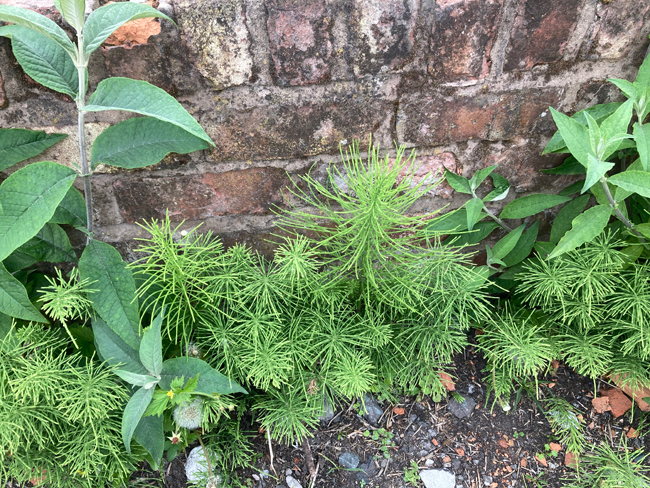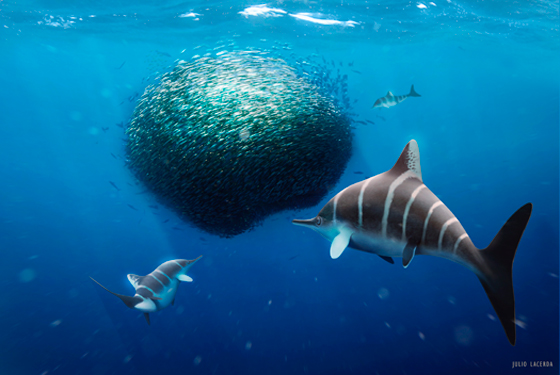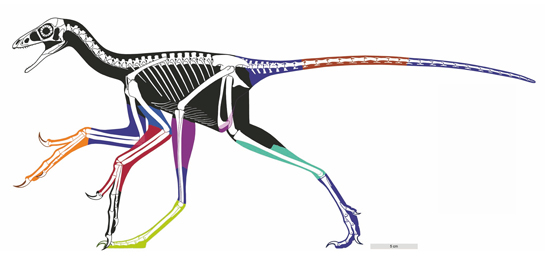Scientists including researchers from the Museum für Naturkunde (Berlin) have identified the oldest leaf mines in the fossil record. In addition, evidence of insect egg deposits has been found in association with these ancient trace fossils. Insect trace fossils in the studied fossil materials are so abundant that the researchers state that this is the oldest evidence of an insect infestation known to science. The plant fossils examined in this ground-breaking research come from several museum collections. The trace fossils record the highly specialised behaviour of insect larvae that lived approximately 295 million years ago.
The research, published in the journal “Scientific Reports” indicates that this specialised feeding behaviour had evolved at least forty million years earlier than previously thought.

The oldest leaf mines (Asteronomus maeandriformis) known to science. A plant fossil from the Permian period collected in Thuringia (left). Leaf mines of the leaf miner fly Liriomyza on a sow thistle (right). Picture credit: Laaß et al (Museum für Naturkunde Berlin).
Picture credit: Laaß et al (Museum für Naturkunde Berlin)
The Advantages of Being a Leaf Miner
In the late spring and summer evidence of the activity of insect larvae feeding inside the leaves of plants is easy to find. The insects produce distinctive channels in the surface of the leaf. Living inside plant tissue has many advantages. For example, the larvae are protected from predators, and they are less prone to harmful infections. In addition, they avoid dehydration, and the larvae have an almost inexhaustible supply of food all around them.
Today, leaf mines are produced exclusively by insects such as beetles, dipterans (flies), wasps and butterflies. They undergo complete transformation (metamorphosis) and are therefore referred to as holometabolous insects. Holometabolous insects have four stages:
- Egg
- Larva
- Pupa
- Adult
Holometabolous insects are highly adaptable and extremely numerous. They have evolved slender, maggot-like larvae without body appendages that are optimally adapted to life inside plant tissue.
Until now, it was unclear when this sophisticated and highly successful strategy emerged in the Insecta. Previously, the oldest reliable evidence of leaf mines came from plant fossils from the Triassic. This new study identifies for the first time leaf mining in Palaeozoic fossils. These oldest leaf mines highlight the importance of conserving museum collections.
The Oldest Leaf Mines
The researchers from the natural history museums in Berlin, Chemnitz, Münster and Osnabrück, the TU Bergakademie Freiberg and Martin Luther University Halle-Wittenberg have been able to prove, leaf mining behaviour occurred more than forty million years earlier than previously thought. The extensive plant fossil collections from the natural history museums in Schleusingen, Berlin and from the Freiberg University collection were examined. These collections contained numerous exceptionally well-preserved specimens of the feeding traces of Asteronomus maeandriformis on leaves of the seed fern Autunia conferta.
The plant fossils come from the coal fields in Crock, Thuringia. These deposits, representing ancient swamps, were laid down in the Early Permian. Close scrutiny of the specimens permitted the team to conclusively prove leaf mining behaviour. In addition, the team identified many of the egg deposits associated with the feeding tunnels, which in some cases even contained the remains of insect eggs.

Numerous types of plants today have extremely ancient lineages. For example, horsetails (Equisetum) continue to thrive as they are able to grow in areas where other plants would find it difficult to get a foothold. Often regarded as weeds, these tough little plants are essentially living fossils as the earliest examples of the genus Equisetum date from the Early Jurassic of South America. Picture credit: Everything Dinosaur.
Picture credit: Everything Dinosaur
Over Eighty Percent of the Fossil Autunia Plants Infested
Evidence of leaf mining was found in more than eighty percent of all the fossilised Autunia plants from Thuringia studied.
Palaeobotanist Ludwig Luthardt, one of the co-authors of the paper stated:
“Why exactly the Autunia plants in Crock were infested en masse remains largely a mystery. However, the phenomenon occurred at a time of global change, during which tropical terrestrial ecosystems gradually became drier. This shows how important it is to look to the past in times of current global climate change.”
Everything Dinosaur acknowledges the assistance of a media release from the Museum für Naturkunde Berlin in the compilation of this article.
The scientific paper: “Host-specific leaf-mining behaviour of holometabolous insect larvae in the early Permian” by Michael Laaß, Ludwig Luthardt, Steffen Trümper, Angelika Leipner, Norbert Hauschke and Ronny Rößler published in Scientific Reports.
The Everything Dinosaur website: Prehistoric Animal Models and Figures.




Leave A Comment